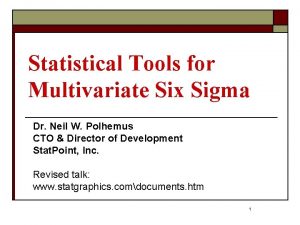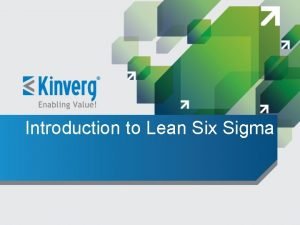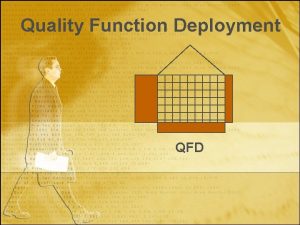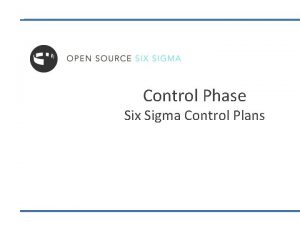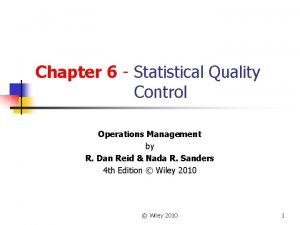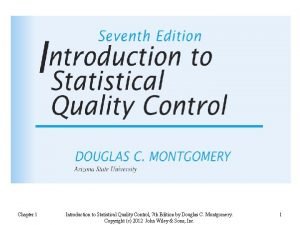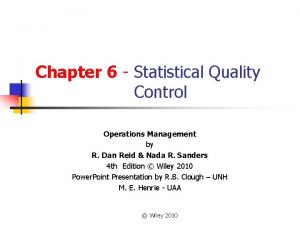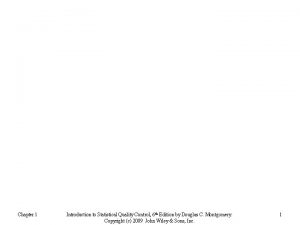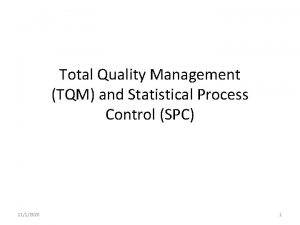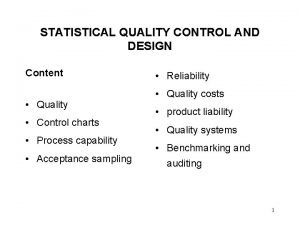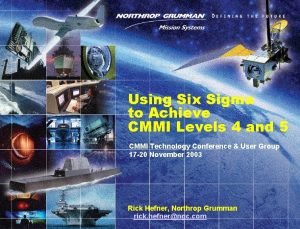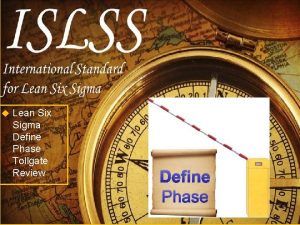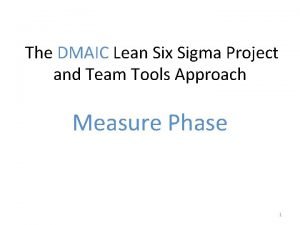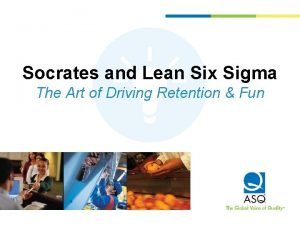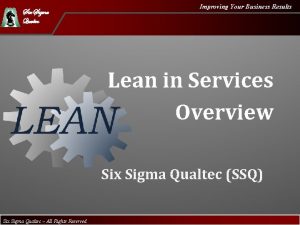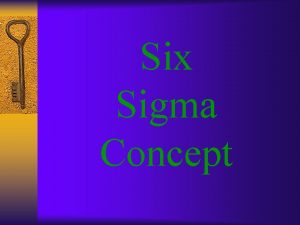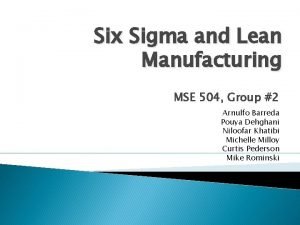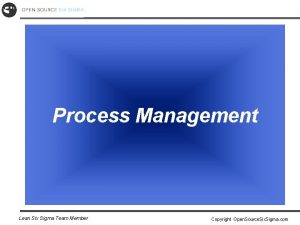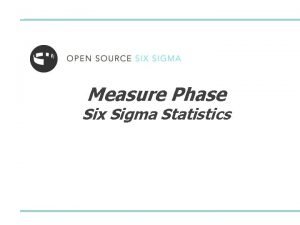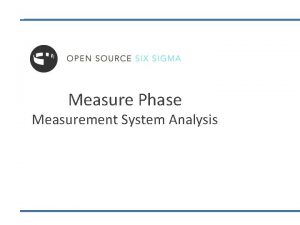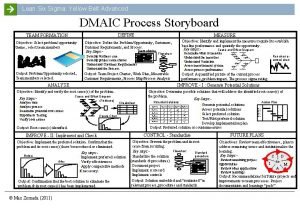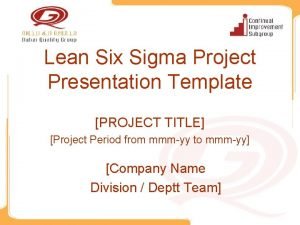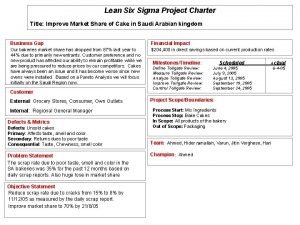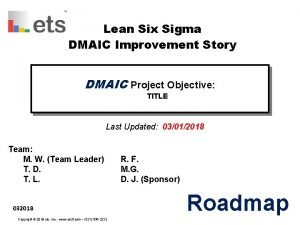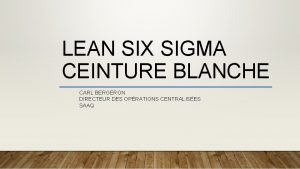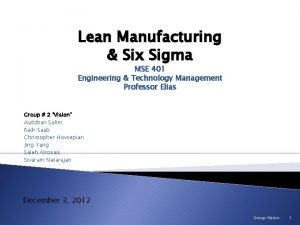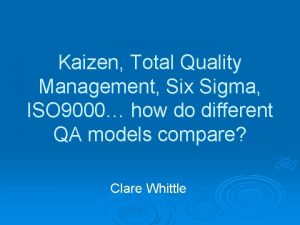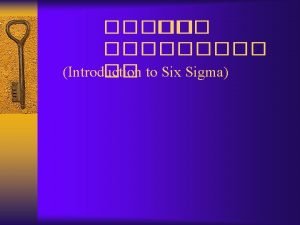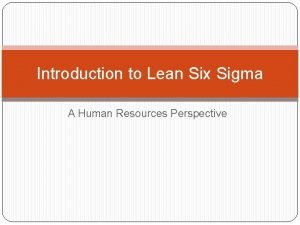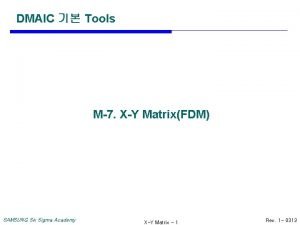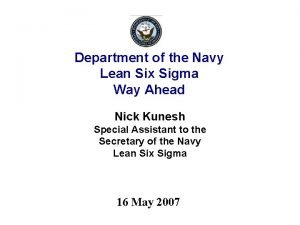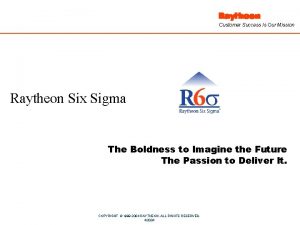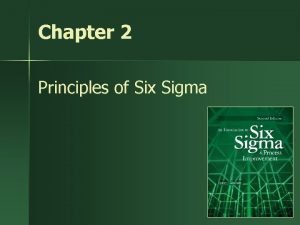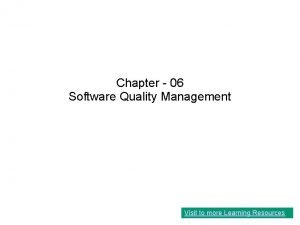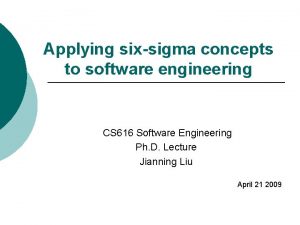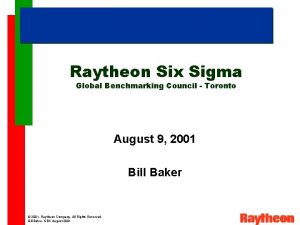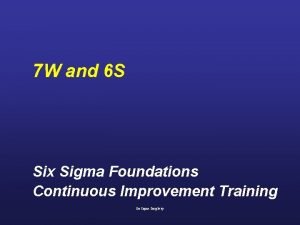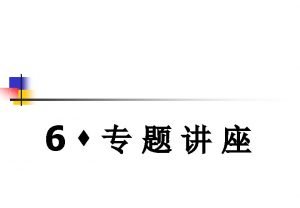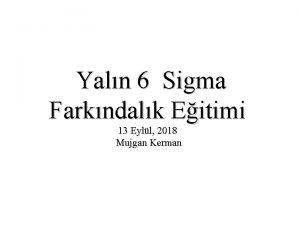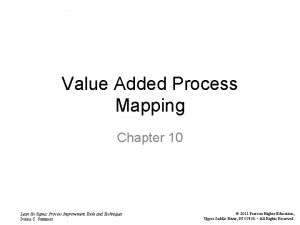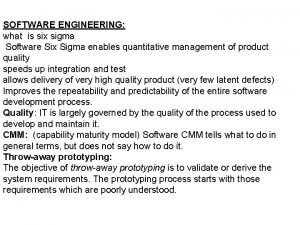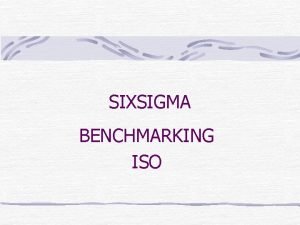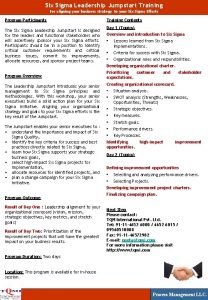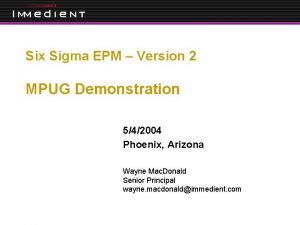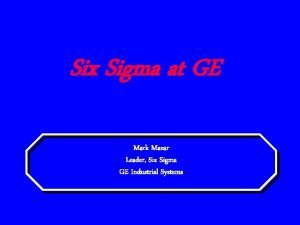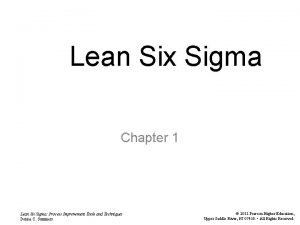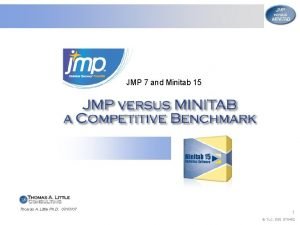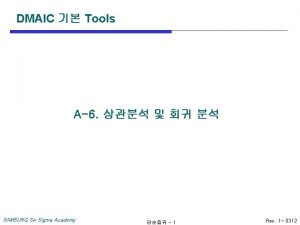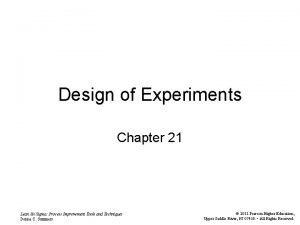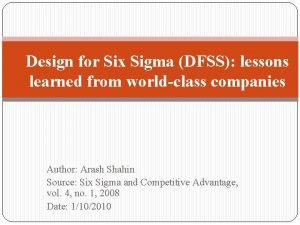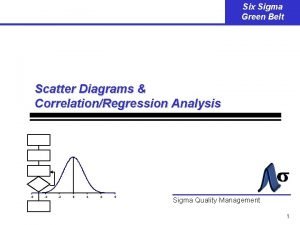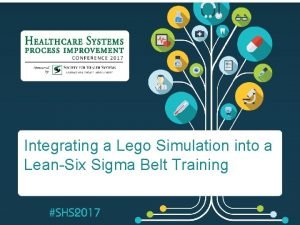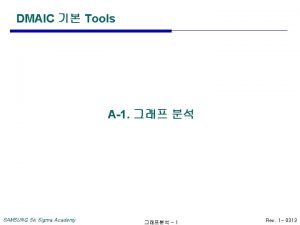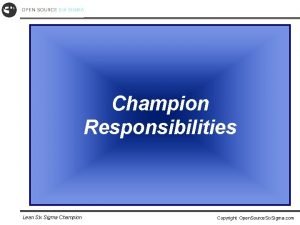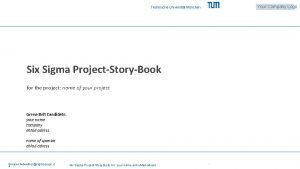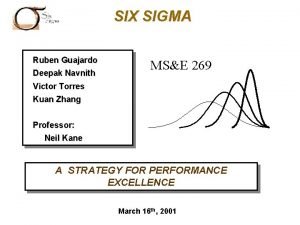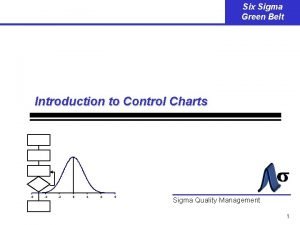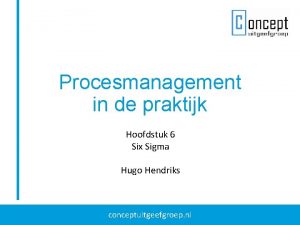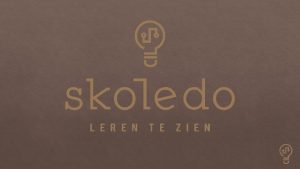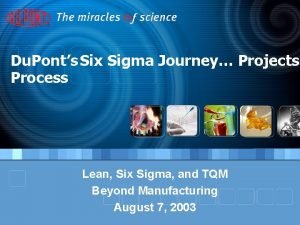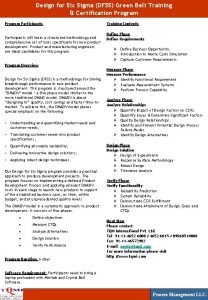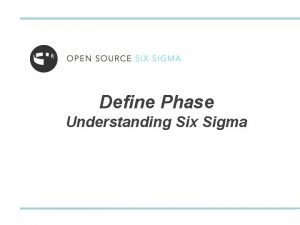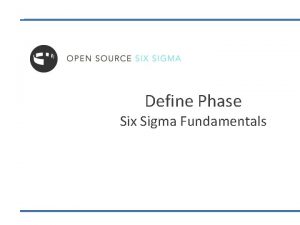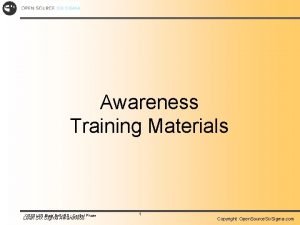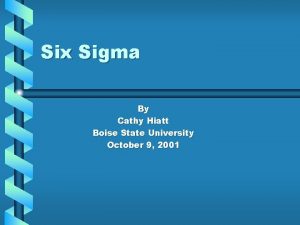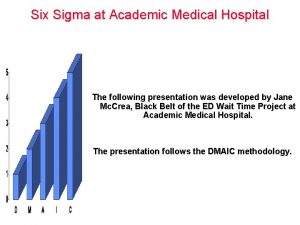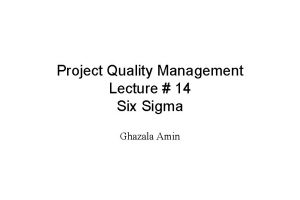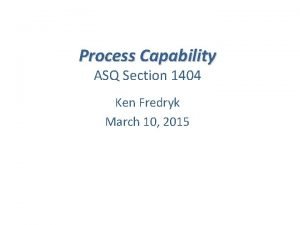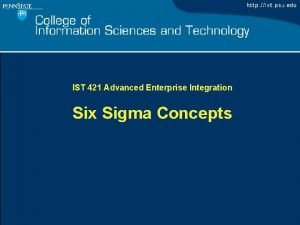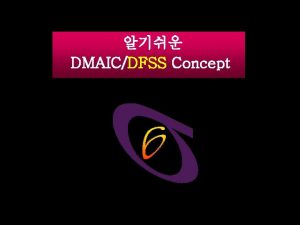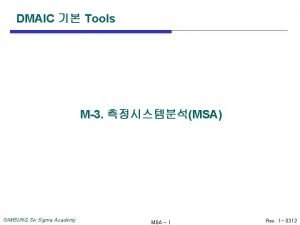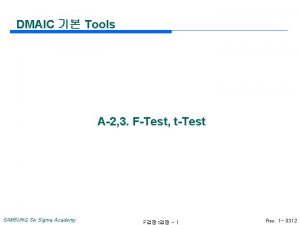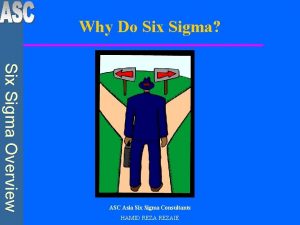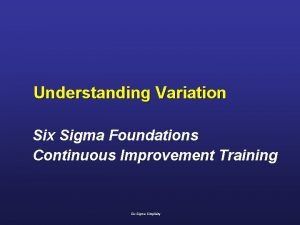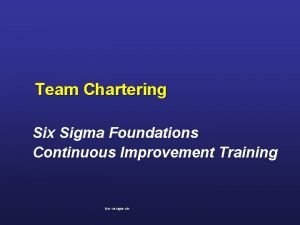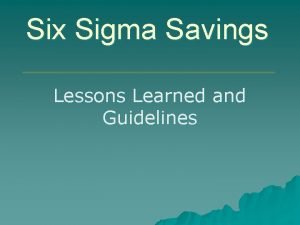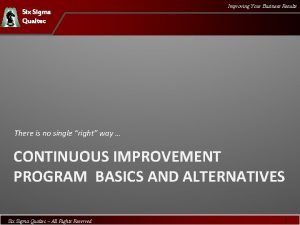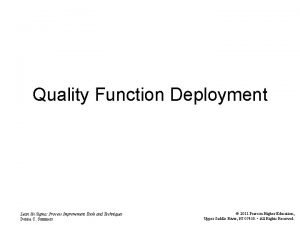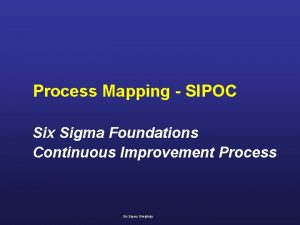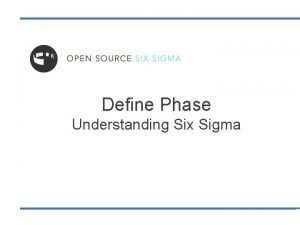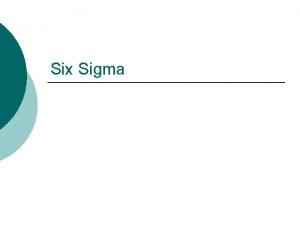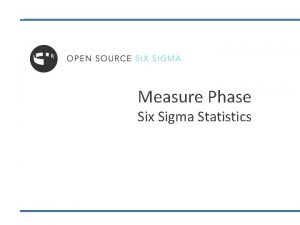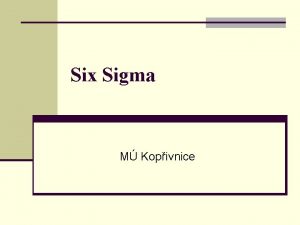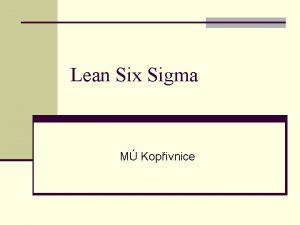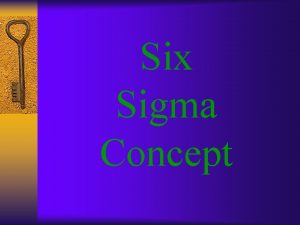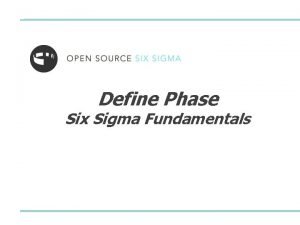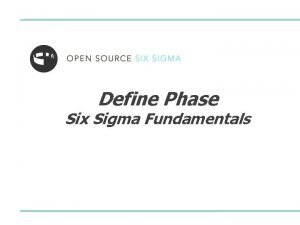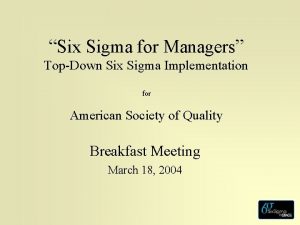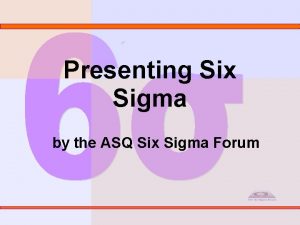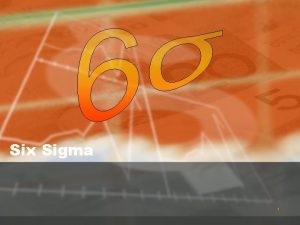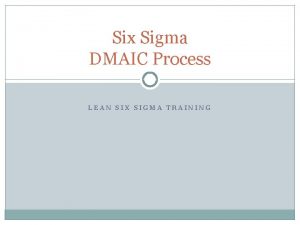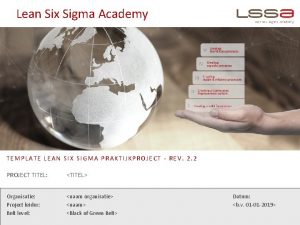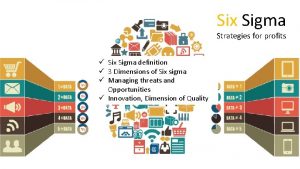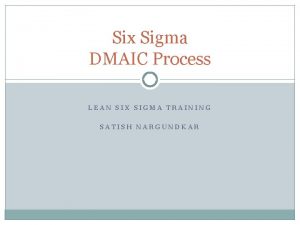Six Sigma and Statistical Quality Control Outline Quality



































































































- Slides: 99

Six Sigma and Statistical Quality Control

Outline • Quality and Six Sigma: Basic ideas and history • Juran Trilogy – Control – Improvement – Planning • Quality Strategy • Focus on Statistical Methods – Process Capability ideas and metrics – Control charts for attributes and variables

A Brief History • The Craft System • Taylorism (Scientific Management) • Statistical Quality Control – Pearson, Shewhart, Dodge • Human Relations School – Mayo, Maslow, Simon, Herzberg, Likert • The Japanese Revolution (1950) – Ishikawa, Taguchi, Deming, Juran, Feigenbaum • The USA Wakes Up (1980) – Crosby • 1990 s: Six Sigma • The Need for Organizational Change

JIT and TQM Walter Shewhart 1891 - 1967 Operations -- Prof. Juran W. Edwards Deming 1900 - 1993 4 Joseph M. Juran 1904 - 2008

What is Quality? • Freedom from Defects – Quality Costs Less – Affects Costs • Presence of Features – Quality Costs More – Affects Revenue

Juran Trilogy Planning, Control, Improvement

Juran Trilogy Planning, Control, Improvement Planning Control Improvement Control Sporadic Spike Chronic Waste

Quality Control • Aimed at preventing unwanted changes • Works best if deployed at the point of production or service delivery (Empowerment) • Tools: – – Established, measurable standards Measurement and feedback Control charts Statistical inference

Quality Control Establish Standard Measure Performance Operate Yes OK? Corrective Action No Compare to Standard

Quality Improvement • Aimed at creating a desirable change • Two distinct “journeys” – Diagnosis – Remedy • Project team approach • Tools – – Process flow diagram Pareto analysis Cause-effect (Ishikawa, fishbone) diagram Statistical tools

Quality Improvement • • Identify problem Analyze symptoms Formulate theories Test theories - Identify root cause • Identify remedy • Address cultural resistance • Establish control

Quality Planning • Aimed at creating or redesigning (reengineering) a process to satisfy a need • Project team approach • Tools – – – Market research Failure analysis Simulation Quality function deployment Benchmarking

Quality Planning • • Verify goal Identify customers Determine customer needs Develop product Develop process Transfer to operations Establish control

Strategic Quality Planning • • Mission Vision Long-term objectives Annual goals Deployment of goals Assignment of resources Systematic measurement Connection to rewards and recognition

Strategic Quality Planning • Aimed at establishing long-range quality objectives and creating an approach to meeting those objectives • Top management’s job • Integrated with other objectives – – Operations Finance Marketing Human Resources


Process Capability • The Relationship between a Process and the Requirements of its Customer • How Well Does the Process Meet Customer Needs?

Process Capability • Specification Limits reflect what the customer needs • Natural Tolerance Limits (a. k. a. Control Limits) reflect what the process is capable of actually delivering • These look similar, but are not the same

Specification Limits • Determined by the Customer • A Specific Quantitative Definition of “Fitness for Use” • Not Necessarily Related to a Particular Production Process • Not Represented on Control Charts

Tolerance (Control) Limits • Determined by the inherent central tendency and dispersion of the production process • Represented on Control Charts to help determine whether the process is “under control” • A process under control may not deliver products that meet specifications • A process may deliver acceptable products but still be out of control

Measures of Process Capability • • Cp Cpk Percent Defective Sigma Level

Example: Cappuccino • Imagine that a franchise food service organization has determined that a critical quality feature of their world-famous cappuccino is the proportion of milk in the beverage, for which they have established specification limits of 54% and 64%. • The corporate headquarters has procured a customdesigned, fully-automated cappuccino machine which has been installed in all the franchise locations. • A sample of one hundred drinks prepared at the company’s Stamford store has a mean milk proportion of 61% and a standard deviation of 3%.

Example: Cappuccino • Assuming that the process is in control and normally distributed, what proportion of cappuccino drinks at the Stamford store will be nonconforming with respect to milk content? • Try to calculate the Cp, Cpk, and Parts per Million for this process. • If you were the quality manager for this company, what would you say to the store manager and/or to the big boss back at headquarters? What possible actions can be taken at the store level, without changing the inherent variability of this process, to reduce the proportion of non-conforming drinks?

Lower Control Limit

Upper Control Limit

Nonconformance

Nonconformance

Nonconformance • 0. 00990 of the drinks will fall below the lower specification limit. • 0. 84134 of the drinks will fall below the upper limit. • 0. 84134 - 0. 00990 = 0. 83144 of the drinks will conform. • Nonconforming: 1. 0 - 0. 83144 = 0. 16856 (16. 856%)

Cp Ratio

Cpk Ratio

Parts per Million

Quality Improvement • Two Approaches: – Center the Process between the Specification Limits – Reduce Variability

Approach 1: Center the Process

Approach 1: Center the Process

Approach 1: Center the Process

Approach 1: Center the Process • 0. 04746 of the drinks will fall below the lower specification limit. • 0. 95254 of the drinks will fall below the upper limit. • 0. 95254 - 0. 04746 = 0. 90508 of the drinks will conform. • Nonconforming: 1. 0 - 0. 90508 = 0. 09492 (9. 492%)

Approach 1: Center the Process • Nonconformance decreased from 16. 9% to 9. 5%. • The inherent variability of the process did not change. • Likely to be within operator’s ability.

Approach 2: Reduce Variability • The only way to reduce nonconformance below 9. 5%. • Requires managerial intervention.

Quality Control Establish Standard Measure Performance Operate Yes OK? Corrective Action No Compare to Standard

Quality Control • Aimed at preventing and detecting unwanted changes • An important consideration is to distinguish between Assignable Variation and Common Variation • Assignable Variation is caused by factors that can clearly be identified and possibly managed • Common Variation is inherent in the production process • We need tools to help tell the difference

When is Corrective Action Required? • Operator Must Know How They Are Doing • Operator Must Be Able to Compare against the Standard • Operator Must Know What to Do if the Standard Is Not Met

When is Corrective Action Required? • Use a Chart with the Mean and 3 -sigma Limits (Control Limits) Representing the Process Under Control • Train the Operator to Maintain the Chart • Train the Operator to Interpret the Chart

Example: Run Chart

When is Corrective Action Required? Here are four indications that a process is “out of control”. If any one of these things happens, you should stop the machine and call a quality engineer: • One point falls outside the control limits. • Seven points in a row all on one side of the center line. • A run of seven points in a row going up, or a run of seven points in a row going down. • Cycles or other non-random patterns.

Example: Run Chart

Type I and Type II Errors

When is Corrective Action Required? One point falls outside the control limits. • 0. 27% chance of Type I Error Seven points in a row all on one side of the center line. • 0. 78% chance of Type I Error A run of seven points in a row going up, or a run of seven points in a row going down. • 0. 78% chance of Type I Error

Basic Types of Control Charts Attributes (“Go – No Go” data) • A simple yes-or-no issue, such as “defective or not” • Data typically are “proportion defective” • p-chart Variables (Continuous data) • Physical measurements such as dimensions, weight, electrical properties, etc. • Data are typically sample means and standard deviations • X-bar and R chart

Statistical Symbols (Attributes)

p-chart Example

p-chart Example



Note: If the LCL is negative, we round it up to zero.


Statistical Symbols (Variables)

X-bar, R chart Example


From Exhibit TN 7. 7




X-bar Chart

R chart

Interpretation • Does any point fall outside the control limits? • Are there seven points in a row all on one side of the center line? • Is there a run of seven points in a row going up, or a run of seven points in a row going down? • Are there cycles or other non-random patterns?

Six Sigma Defined (Low-Level) A Process in which the Specification Limits are Six Standard Deviations above and below the Process Mean Two Approaches: • Move the Specification Limits Farther Apart • Reduce the Standard Deviation

Approach #1 Ask the Customer to Move the Specification Limits Farther Apart.






Approach #2 Reduce the Standard Deviation.






Process Drift What Happens when the Process Mean Is Not Centered between the Specification Limits?





Six Sigma: Many Meanings • • • A Symbol A Measure A Benchmark or Goal A Philosophy A Method

Six Sigma: A Symbol • is a Statistical Symbol for Standard Deviation • Standard Deviation is a Measure of Dispersion, Volatility, or Variability

Six Sigma: A Measure • The “Sigma Level” of a process can be used to express its capability — how well it performs with respect to customer requirements. • Percent Defects, Cpk, PPM

Six Sigma: A Benchmark or Goal • The specific value of 6 Sigma (as opposed to 5 or 4 Sigma) is a benchmark for process excellence. • Adopted by leading organizations as a goal for process capability.

Six Sigma: A Philosophy • A vision of process performance • Tantamount to “zero defects” • A “Management Mantra”

Six Sigma: A Method • Really a Collection of Methods: – Product/Service Design – Quality Control – Quality Improvement – Strategic Planning

Where Does “ 3. 4 PPM” Come From? • Six Sigma is commonly defined to be equivalent to 3. 4 defective parts per million. • Juran says that a Six Sigma process will produce only 0. 002 defective parts per million. • What gives?

Normal Curve Probabilities


Process Centered between Spec Limits

Process Shifted by 1. 5 Standard Deviations

Where Does “ 3. 4 PPM” Come From? • The 3. 4 defective parts per million definition of Six Sigma includes a “worst case” scenario of a 1. 5 standard deviation shift in the process. • It is assumed that there is a very high probability that such a shift would be detected by SPC methods (low probability of Type II error).

Six Sigma in Context • Is Six Sigma dramatically different from old-fashioned quality control? • Is Six Sigma a departure from 1980’sstyle TQM?

Six Sigma in Context • What Is New? – Focus on Quantitative Methods – Focus On Control – A Higher Standard – A New Metric for Defects (PPM) – Lots of training – Linkage between quality goals and employee incentives?

Using Six Sigma • A New Standard; Not Adopted Uniformly across Industries • Beyond Generalities, Need to Develop Organization-Specific Methods • Hard Work, Not Magic • “A Direction Not a Place”

Summary • Quality and Six Sigma: Basic ideas and history • Juran Trilogy – Control – Improvement – Planning • Quality Strategy • Focus on Statistical Methods – Process Capability ideas and metrics – Control charts for attributes and variables
 Six sigma statistical tools
Six sigma statistical tools Six sigma outline
Six sigma outline Qfd six sigma
Qfd six sigma Control plan lean six sigma
Control plan lean six sigma Quality control operations management
Quality control operations management Introduction to statistical quality control montgomery
Introduction to statistical quality control montgomery What is sqc in operations management
What is sqc in operations management Introduction to statistical quality control
Introduction to statistical quality control Spc in total quality management
Spc in total quality management Variables and attributes in quality control
Variables and attributes in quality control Vcom white coat ceremony
Vcom white coat ceremony Edward via college of osteopathic medicine - auburn campus
Edward via college of osteopathic medicine - auburn campus Quality assurance vs quality control
Quality assurance vs quality control Concept of quality assurance
Concept of quality assurance Plan quality management pmp
Plan quality management pmp Pmbok quality assurance vs quality control
Pmbok quality assurance vs quality control Cmmi six sigma
Cmmi six sigma Pilot plan template six sigma
Pilot plan template six sigma Six sigma tollgate
Six sigma tollgate Statapult exercise instructions
Statapult exercise instructions Who is this
Who is this Six sigma qualtec
Six sigma qualtec Lean six sigma forum
Lean six sigma forum Six sigma kpov
Six sigma kpov Mse six sigma
Mse six sigma Dmaic storyboard
Dmaic storyboard Six sigma belts hierarchy
Six sigma belts hierarchy Statistical notation
Statistical notation Msa quality
Msa quality Lean six sigma charter
Lean six sigma charter Pilot plan template six sigma
Pilot plan template six sigma 6 sigma charter
6 sigma charter Six sigma checklist
Six sigma checklist Ceintures six sigma
Ceintures six sigma Mse six sigma
Mse six sigma Six sigma iso 9000
Six sigma iso 9000 Kanban six sigma
Kanban six sigma Kpiv six sigma
Kpiv six sigma Human resources six sigma
Human resources six sigma Six sigma sony
Six sigma sony X-y matrix six sigma
X-y matrix six sigma Lean six sigma navy
Lean six sigma navy Raytheon six sigma
Raytheon six sigma Rolled throughput yield formula
Rolled throughput yield formula A key concept of quality control is that all work products
A key concept of quality control is that all work products Catapult projectile motion
Catapult projectile motion Six sigma strategy in software engineering
Six sigma strategy in software engineering Raytheon six sigma
Raytheon six sigma Lean six sigma foundations
Lean six sigma foundations 4-5
4-5 Lean six sigma nedir
Lean six sigma nedir Six sigma process map symbols
Six sigma process map symbols 6 sigma software
6 sigma software Benchmarking in six sigma
Benchmarking in six sigma Jumpstart six sigma
Jumpstart six sigma Six sigma project hopper template
Six sigma project hopper template Mark mazar
Mark mazar Six sigma kpov
Six sigma kpov Jmp ancova
Jmp ancova Samsung six sigma
Samsung six sigma Full factorial design
Full factorial design Dcov six sigma
Dcov six sigma Six sigma regression
Six sigma regression Lean six sigma simulation games
Lean six sigma simulation games Samsung six sigma
Samsung six sigma Open source six sigma review
Open source six sigma review Six sigma
Six sigma Deepak navnith
Deepak navnith Multivoting six sigma
Multivoting six sigma Six sigma
Six sigma Walter shewhart
Walter shewhart Six sigma betekenis
Six sigma betekenis Voorbeeld project charter
Voorbeeld project charter Dupont six sigma
Dupont six sigma Dfss green belt
Dfss green belt 6 sigma value
6 sigma value Rty six sigma
Rty six sigma Open source six sigma training material
Open source six sigma training material Dpmo six sigma
Dpmo six sigma Chad vs sigma
Chad vs sigma Six sigma boise
Six sigma boise Six sigma at academic medical hospital case analysis
Six sigma at academic medical hospital case analysis Six sigma conversion table
Six sigma conversion table Dpmo calculation in six sigma
Dpmo calculation in six sigma Garland goins
Garland goins Six sigma
Six sigma Which phases were involved in maximum green belt project
Which phases were involved in maximum green belt project Didov six sigma
Didov six sigma 미니탭 gage r&r 해석
미니탭 gage r&r 해석 Samsung six sigma
Samsung six sigma Samsung six sigma
Samsung six sigma Sigma asc
Sigma asc Six sigma foundations
Six sigma foundations Lean six sigma foundations
Lean six sigma foundations Six sigma lessons learned
Six sigma lessons learned Six sigma qualtec
Six sigma qualtec Lean house of quality
Lean house of quality Sigma simplicity
Sigma simplicity Microsoft six sigma
Microsoft six sigma General electric six sigma
General electric six sigma
